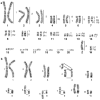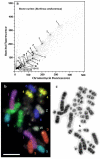Avian comparative genomics: reciprocal chromosome painting between domestic chicken (Gallus gallus) and the stone curlew (Burhinus oedicnemus, Charadriiformes)--an atypical species with low diploid number
- PMID: 19172404
- PMCID: PMC2697597
- DOI: 10.1007/s10577-009-9021-6
Avian comparative genomics: reciprocal chromosome painting between domestic chicken (Gallus gallus) and the stone curlew (Burhinus oedicnemus, Charadriiformes)--an atypical species with low diploid number
Abstract
The chicken is the most extensively studied species in birds and thus constitutes an ideal reference for comparative genomics in birds. Comparative cytogenetic studies indicate that the chicken has retained many chromosome characters of the ancestral avian karyotype. The homology between chicken macrochromosomes (1-9 and Z) and their counterparts in more than 40 avian species of 10 different orders has been established by chromosome painting. However, the avian homologues of chicken microchromosomes remain to be defined. Moreover, no reciprocal chromosome painting in birds has been performed due to the lack of chromosome-specific probes from other avian species. Here we have generated a set of chromosome-specific paints using flow cytometry that cover the whole genome of the stone curlew (Burhinus oedicnemus, Charadriiformes), a species with one of the lowest diploid number so far reported in birds, as well as paints from more microchromosomes of the chicken. A genome-wide comparative map between the chicken and the stone curlew has been constructed for the first time based on reciprocal chromosome painting. The results indicate that extensive chromosome fusions underlie the sharp decrease in the diploid number in the stone curlew. To a lesser extent, chromosome fissions and inversions occurred also during the evolution of the stone curlew. It is anticipated that this complete set of chromosome painting probes from the first Neoaves species will become an invaluable tool for avian comparative cytogenetics.
Figures






References
-
- Auer H, Mayr B, Lambrou M, Schleger W. An extended chicken karyotype, including the NOR chromosome. Cytogenet Cell Genet. 1987;45:218–221. - PubMed
-
- Bed’Home B, Coullin P, Guillier-Gencik S, Moulin S, Bernheim A, Volobouev V. Characterization of the atypical karyotype of the black-winged kite Elanus caeruleus (Falconiformes: Accipitridae) by means of classical and molecular cytogenetic techniques. Chromosome Res. 2003;11:335–343. - PubMed
-
- Bulatova N, Panov E, Radjabli S. Description of karyotypes of some birds from the USSR fauna. Proc USSR Acad Sci. 1971;199:1420–1423.
-
- Burt DW. Origin and evolution of avian microchromosomes. Cytogenet Genome Res. 2002;96:72–112. - PubMed
Publication types
MeSH terms
Grants and funding
LinkOut - more resources
Full Text Sources

